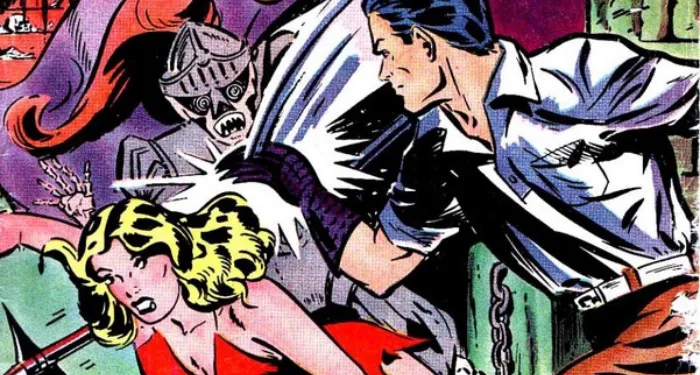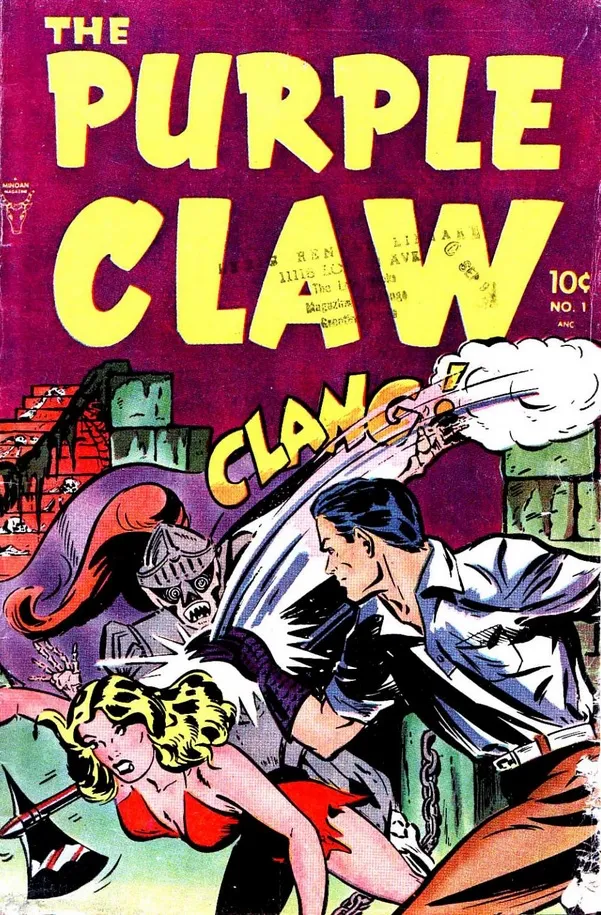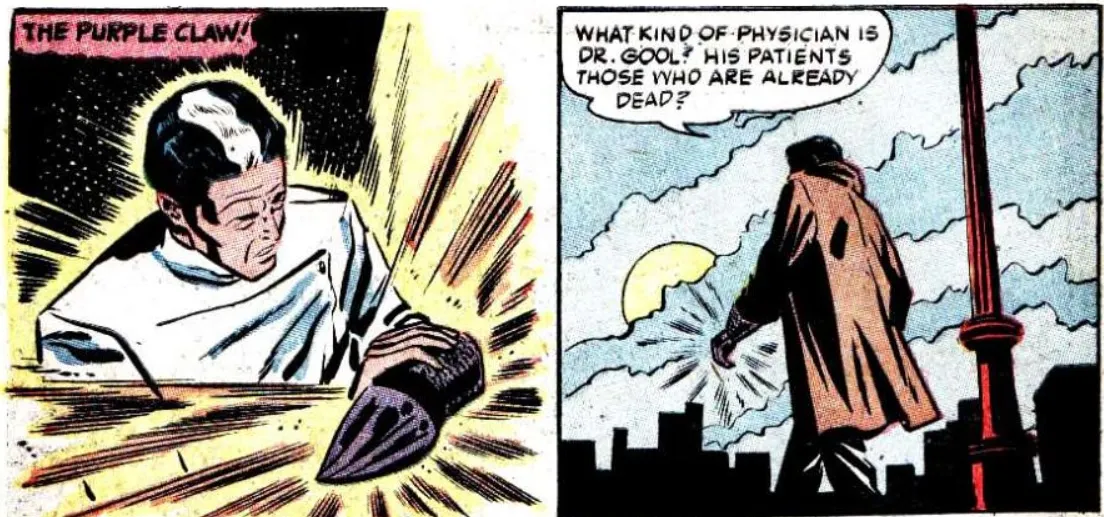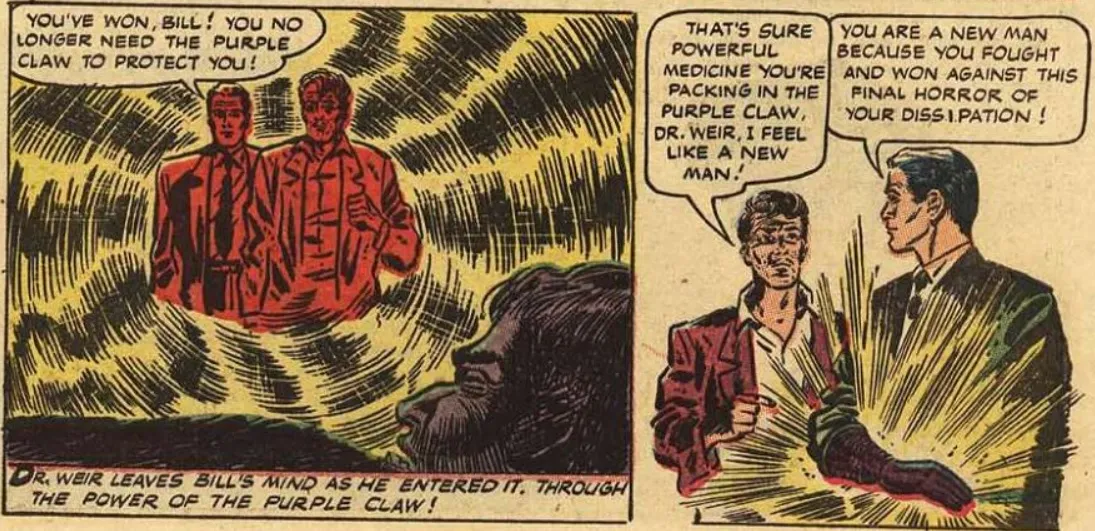
Retro Comic Rewind: The Purple Claw
Some comics go down in history as masterful examples of the craft and are beloved by multiple generations. And others end up at the landfill. In this series, I’ll be looking back on some forgotten series to better understand what kind of comics our ancestral nerds were reading in the days of rotary phones and record players.
Today’s subject: The Purple Claw!

The Context
Lately, it seems that the comics I pick to review all come from the same time period and from creators who had the same goals in mind. It’s the early 1950s. Superheroes are on the wane, but horror comics are on the rise. Let’s combine the two and see what happens!
The Creators
Each of the Purple Claw stories is signed “Brown and Gantz.” I would have assumed that was the writer and artist, but comics.org identifies them as the penciller and inker, Ben Brown and David Gantz. So, whoever wrote these issues is a mystery.
Almost as mysterious is the publisher, which is variously known as Toby Press, Minoan Publishing, and other similar titles. I couldn’t find much on them: they were in business for only six years, though they managed to distinguish themselves by publishing licensed comics featuring characters like Buck Rogers and Felix the Cat.
The Comic
The first issue races through our hero’s origin story, which is brought to you by the letter R for racist.
In 1943, Dr. Jonathan Weir (alas, no one ever calls him Johnny, nor does he ice skate, although he does go on a ski vacation and fight a snow monster) crash-lands in the Congo and is saved by a witch doctor with a mystic, purple-clawed glove. In return, Weir educates the local population about how mosquitoes cause malaria, thus saving lives. (Some Africans had already figured that out on their own, but the location where Weir crashed appears to be somewhere else on the continent, so I will let this go with a suspicious squint rather than a rant.)
In gratitude, the witch doctor gifts him the Purple Claw, which can, as Issue Two puts it, “combat the horrors of the beyond.” His powers remain pretty vague. What does the Claw do, exactly? How does it repel evil? A bad guy in Issue One describes its touch as feeling like “fingertips of fire” on his heart, but that’s as close as we get to an explanation. It’s also mentioned that Weir has “supernaturally keen” senses thanks to the Claw.
Dude doesn’t even bother with a secret identity. At best, he just throws on a trench coat.

Most of his adventures seem to involve combating humans who have turned into something else: the undead, snakes (adorably called were-snakes), man-eating plants, etc. They can also be lazy in spots: the very first story, “The Power of the Purple Claw,” has Weir confront a mad scientist, Dr. Gool, who wants to take over the world with zombies…and yet, the only thing we see Gool do with his zombies is have one cash a check for him. That doesn’t seem like the most put-together plan, but I guess it’s useful if you don’t feel like going all the way to the bank.
In a surprisingly, uh, sober final story, “The Final Terror,” Weir helps an alcoholic by being super judgey about his problems and forcing him to fight the supernatural manifestation of his addiction. That’s how that works, right?

The Legacy
Even though Purple Claw’s title lasted less than six months, he has continued to make sporadic appearances in other comics. Stories from these issues were reprinted in other Toby titles, and once Toby went under, the Purple Claw was acquired by I.W. Publishing, which did almost nothing with him.
In the late 1980s, the Purple Claw was one of many characters acquired by AC Comics, which intermittently featured both reprints and new adventures in various titles until the mid-2000s. In 2010, IDW also reprinted a couple of the classic stories, but nobody seems to care enough to sponsor a wholesale reboot like we saw with the T.H.U.N.D.E.R. Agents.
It’s easy to understand the lack of interest. Dr. Strange hadn’t been invented yet, but Dr. Weir(d) still feels like a generic brand knockoff of him. (He’s even got the odd patches of gray hair for crying out loud.) I can definitely see why Purple Claw never caught on, even though, if you take the racist bits out, he’s not devoid of merit. Since Dr. Strange is still around, the idea of a non-traditional superhero who dabbles in the dark arts can be a winner when approached correctly.
Want more vintage goodness? Check out previous editions of RCR: Race for the Moon, Stamps Comics, Tippy Teen, Winnie Winkle, Hangman Comics, G.I. in Battle, Adventures in Wonderland, The Man from U.N.C.L.E. (1993), The Arrow, Weird Horrors, Ghost Rider, and Crimes by Women!











